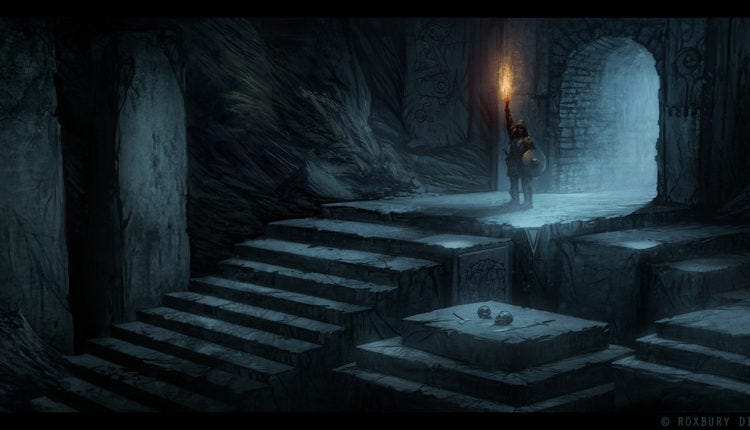There’s something about the dungeon adventure that just works.

You’re in a room. The room has a thing in it. You do the thing, then ya kick down the door and do it all over again in another room. Easy for players to grok, easy for DMs to run.
Some people say all adventures are dungeons, but I’d go the other way. All dungeons are adventures. Or another way, all dungeons are story, and we, as humans, gravitate to story on some weird, primal level. Stories are made of scenes and each scene is packed full of conflict. The hero’s in a scene, they’re doing something, saving something, fighting something, all the while we’re wondering 'what’s going to happen next?'. And then, the scene ends, we find out what happens, the tension resolves and there’s a transition to the next scene. And dungeons, with their scene by scene room by room structure aren’t too far off from that.
Ok, bit of a tangent. Let’s start over.
Dungeons work because you’ve got walls and halls. The walls define the encounter space or the ‘scene’, and the halls lead or ‘transition’ you from one scene to the next. So how the heck can you have all the excitement of a dungeon outside, where there’s no walls to keep the fun encounters in, or halls to lead players to the next encounter? What’s to keep the players from wandering off into the unexplored (and more importantly, unmapped) outdoors where nothing’s going on? They’re not even still in the ‘dungeon’ at that point!
I think that’s all less important than you think. I know adventures games never actually go past level 3ish, but a team of high enough wizards can stray from your walled corridors as easy as one can step off the forest path. Or what if your players get enterprising and start bringing mining equipment and explosives into your dungeons?
There are reasons players stay on the path underground (namely, convenience). There are reasons you use the path when you go for walks through the woods (you occasionally stray, yes. We’ll get there. All in good time.). And there should be reasons for players to stay within the ‘soft’ walls you create for your outdoor dungeon.
But like I said, that stuff’s not so important.
Earlier I misled you. I said dungeons work because they've got walls and halls. But there's something else. One more oft-overlooked thing, integral to a dungeon's structure, that tends to get rolled into the ‘halls.’ And being intentional about the inclusion of this thing is going to be the key to creating our outdoor dungeon.
Dungeons have doors. And doors are important.
Next week we’ll start with the first of our ‘rules’ for making an outdoor dungeon.
